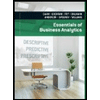Investigation of Spending This assignment aligns with Outcome 3: Explore the role of artificial intelligence in enabling fraud detection and business valuation. Tom is a senior-level project manager at a small construction management company. The company is comprised of less than 20 individuals and has brought in revenue of over $5 million each year for the past five years. Due to the close working relationships of all coworkers, many of the day-to-day responsibilities are shared and there seems to be a lack of segregation of duties. This is especially true on the upper-management level. Tom is currently the acting CFO and works with the accountants in the preparation of financial statements. Two other senior-level coworkers have noticed a change in Tom’s lifestyle and have become concerned regarding the source of his finances. He shows up to work in expensive vehicles, brags about his lavish weekend trips, and his choice in work attire has certainly upgraded over the past year. His coworkers are concerned because net profit is down and the firm keeps committing to large supply contracts with the same vendor. When confronted in a meeting, Tom is argumentative and dismissive, which are characteristics not seen from the Tom his coworkers have grown to respect. The firm hires you to conduct an investigation into this. Below is a general outline of Tom’s spending for the year: In Excel, use the data below to create a Form 4822 similar to the one in Figure 6.2 of your textbook to determine Tom’s living expenses. Analyze the data and form an opinion on Tom’s spending. Is there enough evidence to determine that a fraud may be taking place? What areas within the company can you look at to determine whether fraud has occurred? Total Yearly Gross Income: $130,000.00 Groceries and outside meals: $18,000 Clothing: $15,000 Laundry dry cleaning: $500 Education: $750 (student loans) Recreation, entertainment, vacations: $25,000 Subscriptions: $750 Gifts and allowances: $6,000 Life and accident insurance: $1,800 Federal taxes: $30,000 Rent or mortgage: $3,500/month Utilities: $3,750 Domestic help: $0 Home insurance: $1,500 Repairs and improvements: $5,000 Child care: $0 Gasoline, oil, grease, wash: $1,500 Tires, batteries, repairs, tags: $2,000 Insurance: $3,000 Auto payments (including interest): $0 Lease of auto: $18,000 Other personal assets: $10,000 All medical expenses paid by employer’s generous health plan.
Investigation of Spending
This assignment aligns with Outcome 3: Explore the role of artificial intelligence in enabling fraud detection and business valuation.
Tom is a senior-level project manager at a small construction management company. The company is comprised of less than 20 individuals and has brought in revenue of over $5 million each year for the past five years. Due to the close working relationships of all coworkers, many of the day-to-day responsibilities are shared and there seems to be a lack of segregation of duties. This is especially true on the upper-management level. Tom is currently the acting CFO and works with the accountants in the preparation of financial statements.
Two other senior-level coworkers have noticed a change in Tom’s lifestyle and have become concerned regarding the source of his finances. He shows up to work in expensive vehicles, brags about his lavish weekend trips, and his choice in work attire has certainly upgraded over the past year. His coworkers are concerned because net profit is down and the firm keeps committing to large supply contracts with the same vendor. When confronted in a meeting, Tom is argumentative and dismissive, which are characteristics not seen from the Tom his coworkers have grown to respect.
The firm hires you to conduct an investigation into this. Below is a general outline of Tom’s spending for the year:
- In Excel, use the data below to create a Form 4822 similar to the one in Figure 6.2 of your textbook to determine Tom’s living expenses.
- Analyze the data and form an opinion on Tom’s spending.
- Is there enough evidence to determine that a fraud may be taking place?
- What areas within the company can you look at to determine whether fraud has occurred?
Total Yearly Gross Income: $130,000.00
Groceries and outside meals: $18,000
Clothing: $15,000
Laundry dry cleaning: $500
Education: $750 (student loans)
Recreation, entertainment, vacations: $25,000
Subscriptions: $750
Gifts and allowances: $6,000
Life and accident insurance: $1,800
Federal taxes: $30,000
Rent or mortgage: $3,500/month
Utilities: $3,750
Domestic help: $0
Home insurance: $1,500
Repairs and improvements: $5,000
Child care: $0
Gasoline, oil, grease, wash: $1,500
Tires, batteries, repairs, tags: $2,000
Insurance: $3,000
Auto payments (including interest): $0
Lease of auto: $18,000
Other personal assets: $10,000
All medical expenses paid by employer’s generous health plan.
Unlock instant AI solutions
Tap the button
to generate a solution






